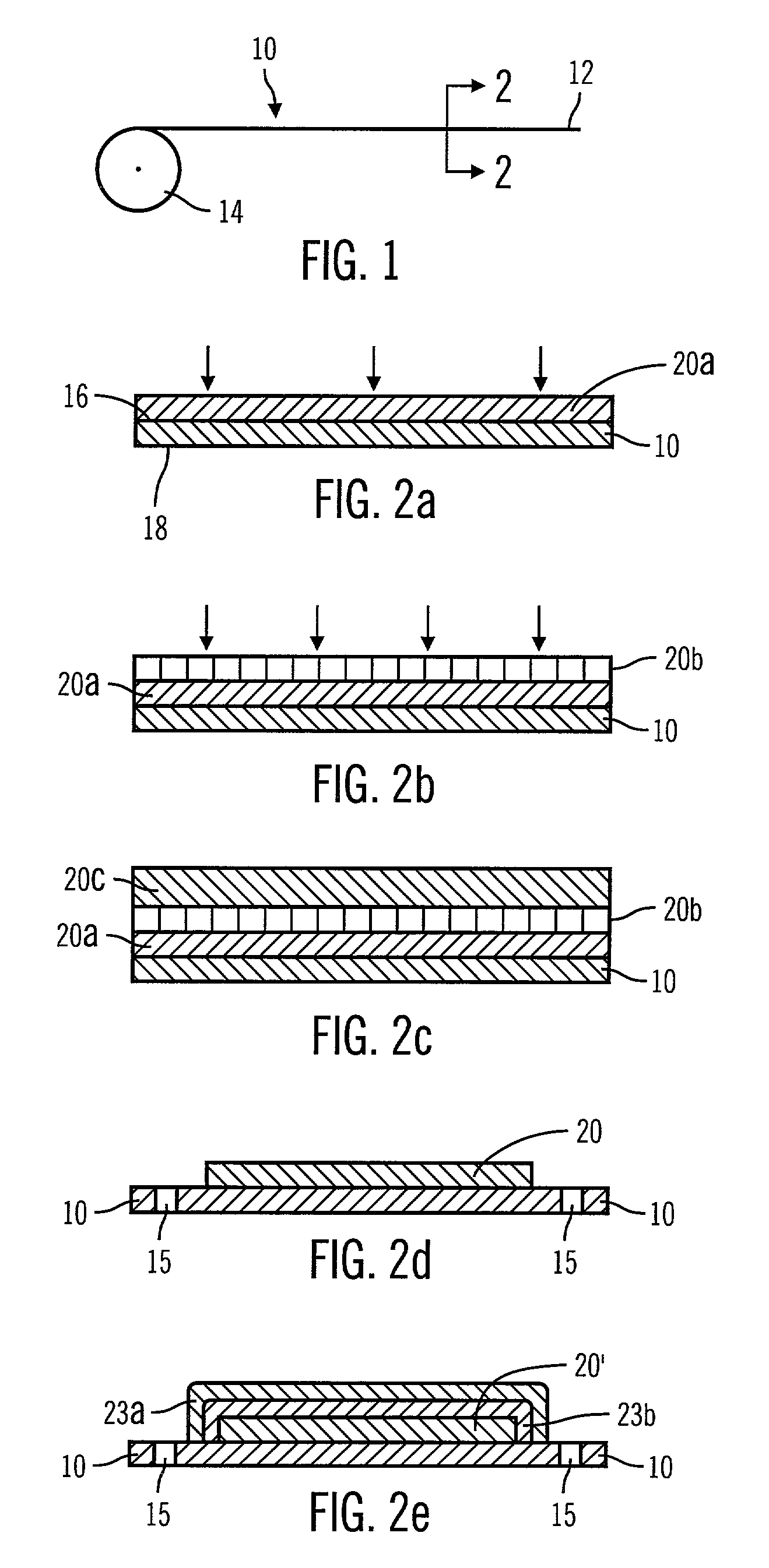Analyte sensor method of making the same
a technology of analyte sensor and sensor body, which is applied in the field of analyte sensor, can solve the problems of time-consuming and expensive step procedures
- Summary
- Abstract
- Description
- Claims
- Application Information
AI Technical Summary
Benefits of technology
Problems solved by technology
Method used
Image
Examples
first embodiment
[0073]Referring now to FIGS. 1–4, a substrate 10 is provided in accordance with the inventive method. In preferred embodiments, substrate 10 is a flexible, self-supporting substrate in the form of a continuous tape 12 supplied from a reel 14. The continuous tape 12 is preferably formed from a polymeric material such as a polyimide. However, other flexible, self-supporting materials can be used. The thickness of tape 12 is preferably about 10μ to 125μ. However, in alternative embodiments, thinner or thicker films from 5μ to 500μ may be used. In particular embodiments, sprocket holes 15 (see FIG. 2c) are formed in the substrate adjacent the outer edge of the tape 12 to facilitate manufacturing of the sensors through automated processes. For instance, the tape 12 is fed through stages that perform various steps of the methods described in this application. Sensor electrodes 20 can be formed on the tape 12 using techniques described in “3M Specifications and Design Guidelines, Microflex...
second embodiment
[0108] a non-impact process is used to form the sensor electrodes 324. Exemplary non-impact processes include electrophotography and magnetography, in which an image of the conductive traces is electrically or magnetically formed on a drum 320. The image attracts a toner material 322 to the drum. The toner 322 material is subsequently transferred to the substrate 310, for example by rolling, followed preferably by a curing step to adhere the toner material to the substrate. See FIG. 24. Other useful non-impact processes include ink jet printing and piezo jet printing, in which an image is formed by ejection of a conductive material, such as a conductive ink, onto the substrate. Still other useful non-impact processes include the use of photosensitive resins to form a layer on the substrate in which channels are defined, followed by filling the channels with conductive material to form the sensor electrodes.
third embodiment
[0109] a film of conductive material 332 is formed, for example, as a continuous sheet or as a coating layer deposited on a carrier film 330. The film is brought, for example, between a print head 334 and the substrate 310. A pattern of sensor electrodes 336 is formed on the substrate 310 using the print head. The conductive material is transferred by pressure and / or heat to the substrate 310. See FIGS. 25a–b. Channels can be formed in the substrate as a result of the printing process, or alternatively the conductive material can be deposited on the substrate substantially without the formation of depressions or channels.
[0110]Once the sensor electrodes have been formed, a bead 342 can be provided in accordance with the methods described above.
[0111]FIGS. 26–29 illustrate a sensor 400 formed in accordance with another embodiment of the present invention. The sensor 400 includes a substrate 402 and at least one sensor electrode 404 formed from one or more conductive layers. In partic...
PUM
 Login to View More
Login to View More Abstract
Description
Claims
Application Information
 Login to View More
Login to View More - R&D
- Intellectual Property
- Life Sciences
- Materials
- Tech Scout
- Unparalleled Data Quality
- Higher Quality Content
- 60% Fewer Hallucinations
Browse by: Latest US Patents, China's latest patents, Technical Efficacy Thesaurus, Application Domain, Technology Topic, Popular Technical Reports.
© 2025 PatSnap. All rights reserved.Legal|Privacy policy|Modern Slavery Act Transparency Statement|Sitemap|About US| Contact US: help@patsnap.com



